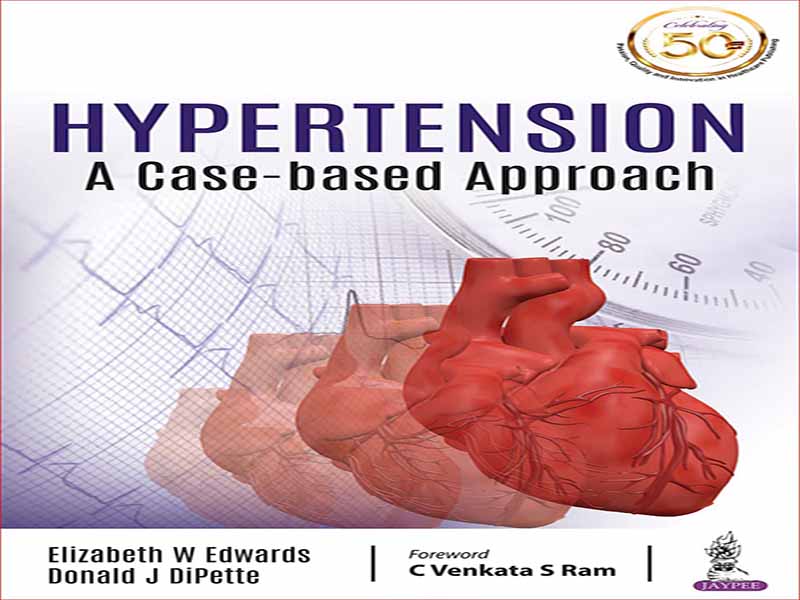- عنوان کتاب: Hypertension. A Case-Based Approach
- نویسنده: Elizabeth W Edwards
- حوزه: فشار خون
- تعداد صفحه: 399
- سال انتشار: 2020
- زبان اصلی: انگلیسی
- نوع فایل: pdf
- حجم فایل: 7.88 مگابایت
فشار خون بالا به عنوان قاتل خاموش توصیف شده است زیرا در بسیاری از تاریخ طبیعی خود بدون علامت است. با این حال، آسیب طولانی مدت اندام هدف مرتبط با افزایش فشار خون قطعاً خاموش نیست. در گذشته، برخی از مقامات فشار خون بالا را به عنوان یک مکانیسم جبرانی برای حفظ جریان خون به اندام های حیاتی در پاسخ به بیماری های عروق محیطی می دانستند. با این حال، این عقیده قبلی اکنون به طور چشمگیری تغییر کرده است: فشار خون بالا یک عامل خطر اصلی برای بیماری قلبی (شامل انفارکتوس میوکارد، هیپرتروفی بطن چپ، آریتمی و نارسایی احتقانی قلب)، بیماری عروق مغزی (شامل ایسکمی، سکته مغزی، و زوال عقل) است. بیماری کلیوی (نارسایی مزمن و مرحله نهایی کلیه) و مرگ. علاوه بر این، میزان آگاهی، درمان و کنترل جمعیت جهانی از فشار خون بالا بسیار پایین است که به افزایش بار بیماری های غیرواگیر جهانی کمک می کند. بنابراین، ضروری است که بخش های بهداشتی، دولتی و عمومی در مورد فشار خون بالا و پیامدهای آن آگاه باشند و اطلاعات را در سطوح محلی، منطقه ای و ملی منتشر کنند. امیدواریم کارآموزان متخصص بهداشت در مورد پاتوفیزیولوژی بیماری آگاهی عمومی را برای تشخیص، پیشگیری و کنترل فشار خون بالا افزایش دهند. این کتاب از فرمت مبتنی بر مورد بالینی برای آموزش مفاهیم و یادگیری سیمانی استفاده می کند. هر فصل با یک مقدمه و یک سناریوی موردی شامل پیشینه، تلاش های قبلی برای کنترل فشار خون بالا و چالش ها و موانع در صورت وجود شروع می شود. نویسندگان درمان ها و مداخلات و همچنین نتایج را مورد بحث قرار می دهند و مرواریدها و مشکلات بالینی را برجسته می کنند. هدف کتاب بر تکامل کلی آموزش و سبکهای یادگیری استوار است و به خوانندگان این امکان را میدهد تا دادهها را تجزیه و تحلیل کنند و مفاهیم را در سناریوهای بالینی معتبر و در نتیجه درمان هر بیمار جداگانه به کار ببرند. این کتاب به سه بخش تقسیم شده است. بخش 1، مشتمل بر هشت فصل، مفاهیم کلی مرتبط با فرآیند فشار خون را پوشش می دهد. خوانندگان با دستورالعمل های فعلی مدیریت فشار خون از جمله درمان های دارویی اولیه و بعدی فشار خون بالا آشنا خواهند شد. ما خوشحالیم که توانستیم دستورالعملهای فشار خون بالا را که اخیراً منتشر شده از انجمن قلب آمریکا (AHA) و کالج آمریکایی قلب و عروق (ACC) درج کنیم. آسیب اندام هدف ناشی از فشار خون بالا موضوع مهمی در این بخش است زیرا مستقیماً به عوارض و مرگ و میر فشار خون بالا کمک می کند. مدیریتهای دارویی و غیر دارویی فشار خون بالا و همچنین تفاوتهای جمعیتی مورد بحث قرار گرفتهاند. علاوه بر این، حساسیت به نمک و مقاومت به نمک، یک مفهوم کلی مهم با کاربردهای بالینی مستقیم برای افراد مبتلا به فشار خون، به تفصیل شرح داده شده است. بخش 1 شامل فصلی است که یک رویکرد منحصر به فرد برای مدیریت فشار خون را توصیف می کند: طراحی مجدد یک کلینیک مراقبت های اولیه بین رشته ای برای بهینه سازی کنترل فشار خون. این بخش با ارزیابی پزشکی مبتنی بر شواهد برای مدیریت بالینی فشار خون به پایان می رسد. بخش 2 فشار خون بالا را در 9 جمعیت ویژه بررسی می کند: بیماران مبتلا به بیماری های قلبی عروقی، سکته مغزی، بیماری مزمن کلیوی، بیماری عروقی مجدد، دیابت، و آپنه خواب. افراد باردار؛ بیماران مبتلا به فشار خون کت سفید؛ و کودکان و نوجوانان. در نهایت، بخش 3 رویکرد فشار خون بالا را هنگامی که اقدامات اولیه با شکست مواجه می شود، توضیح می دهد. این بخش شامل بحث پرفشاری خون مقاوم، ارزیابی علل ثانویه فشار خون بالا و فوریت و اورژانس فشار خون بالا می باشد. ما معتقدیم که کمک های این کتاب درسی که توسط کارشناسان بین المللی و معتبر نوشته شده است، به دانش آموزان و متخصصان مراقبت های بهداشتی کمک می کند تا زمینه وسیع فشار خون و پیچیدگی های آن را بهتر درک کنند. نتیجه این درک افزایش یافته باید درمان و کنترل فشار خون بالا و عوارض و مرگ و میر آن را بهبود بخشد.
Hypertension has been described as the silent killer since it is without symptoms for much of its natural history. However, the long-term target organ damage associated with elevated blood pressure is definitely not silent. In the past, some authorities have viewed elevated blood pressure as a compensatory mechanism to preserve blood flow to vital organs in response to peripheral vascular diseases. However, this previous dogma has now changed dramatically: high blood pressure is a major risk factor for cardiac disease (including myocardial infarction, left ventricular hypertrophy, arrhythmias, and congestive heart failure), cerebrovascular disease (including ischemia, stroke, and dementia), renal disease (chronic and end stage renal failure), and death. Furthermore, the global population’s awareness, treatment, and control rates of hypertension are dismally low, which contributes to the increasing global non-communicable disease burden. Thus, it is imperative that the healthcare, governmental, and public sectors be knowledgeable regarding hypertension and its consequences and disseminate information at local, regional, and national levels. It is our hope that trainees health professionals regarding the pathophysiology of the disease will raise public awareness for hypertension detection, prevention, and control. This book employs a clinical case-based format to teach concepts and cement learning. Each chapter begins with an introduction and a case scenario including background, previous attempts at controlling high blood pressure, and challenges and obstacles, if any. The authors discuss treatments and interventions, as well as outcomes, and highlight clinical pearls and pitfalls. The intent of the book builds on the general evolution of education and learning styles and allows readers an opportunity to analyze data and apply concepts to authentic clinical scenarios and thus the treatment of the individual patient. The book is divided into three sections. Section 1, consisting of eight chapters, covers general concepts associated with the hypertensive process. Readers will learn about current guidelines of hypertension management including the initial and subsequent pharmacologic treatments of an elevated blood pressure. We are pleased to have been able to include the recently released hypertension guidelines from the American Heart Association (AHA) and the American College of Cardiology (ACC). Target organ damage from hypertension is an important topic in this section since it contributes directly to the morbidity and mortality of hypertension. Pharmacologic and non-pharmacologic managements of high blood pressure, as well as population differences, are discussed. In addition, salt-sensitivity and saltresistance, an important general concept with direct clinical applications to the hypertensive individual, is detailed. Section 1 includes a chapter describing a unique approach to hypertension management: that of redesigning an interdisciplinary primary care clinic to optimize blood pressure control. The section concludes with an assessment of the evidencebased medicine for clinical management of hypertension. Section 2 examines hypertension in nine special populations: patients with cardiovascular disease, stroke, chronic kidney disease, renovascular disease, diabetes, and sleep apnea; pregnant individuals; patients with white-coat hypertension; and children and adolescents. Finally, Section 3 describes the approach to hypertension when initial measures fail. This section includes a discussion of resistant hypertension, evaluation of secondary causes of hypertension, and hypertensive urgency and emergency. We believe that the contributions of this textbook, authored by international and respected experts, will help students and practicing healthcare professionals better understand the vast field of hypertension and its complexities. The result of this enhanced understanding should improve the treatment and control of hypertension and its morbidity and mortality.
این کتاب را میتوانید بصورت رایگان از لینک زیر دانلود نمایید.
Download: Hypertension. A Case-Based Approach




































نظرات کاربران